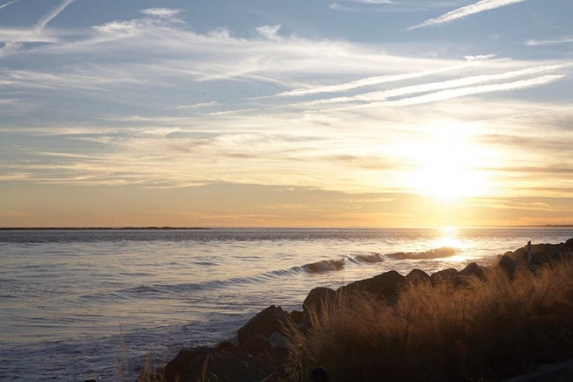This South Carolina spot leaves travelers fully immersed in nature

Seabrook Island is a private golf, tennis, and equestrian community just south of Charleston in South Carolina.
I’m on my second loop around the southern point of Seabrook Island in South Carolina, about a half-hour south of Charleston, pedaling along the wide bends. It’s June. Gray-green wisps taper from the branches of massive live oaks—trees that have survived hurricanes and civil war. An egret loiters in the driveway of a huge blue house on a corner lot with a wrap-around porch. Sightseeing is what you make of it on Seabrook.
As I ride to the corner of High Hammock and Seabrook Island roads, a young couple and a tall, middle-aged man have gathered at the edge of a pond. They’re bending low, pointing at the water. I steer toward them and coast to a stop.
“You see the gator?” the tall man asks me.
I see a log.
He motions me closer. I leave my bike and walk to the water’s edge where the man hunches down so his shoulder is at my eye-level. “He’s way out in the back there,” he says, pointing. “See his nose?”
I see it now: a half-submerged head, then nostrils, floating, just across the pond. To get a closer look, I trespass through the yard of an octagon-shaped rental on stilts. Beach towels sunbathe on the deck. Now I’m less than five feet from two eyes that don’t acknowledge me.
I think about how the reptile lives, about how long it’s been here. I think about reaching out to snap a photo. And the value of my arm. When I look up, the couple and the tall man have left, and I soon realize I’ve spent nearly an hour with this jagged creature that will not move and has no interest in me. And I’m okay with that.
Seabrook Island isn’t a place you go to check off boxes from a list on a tourism website. There are no “must-see attractions” or billboards with directives. There are no Rainforest Cafes, no chains at all, except a couple of stores at Freshfields Village, a swanky shopping area just outside the Seabrook gate, which it shares with neighboring Johns and Kiawah islands. It’s not loud. It’s not crowded. It’s a slow-moving place where the charm lies in what it isn’t—a place where four strangers consider scouting gators an acceptable way to pass a morning.
The island is named for the Seabrook family, beginning with Robert Seabrook, an English businessman who traveled to present-day Charleston at the end of the 17th century.
Despite a conviction for trading with pirates, he amassed a fortune and thousands of acres of coastal land. By the 1800s, the area’s fertile soil yielded industry crops: rice, cotton, indigo. Later the next century, the town was incorporated and developed into the private golf, tennis, and equestrian community it is today.
Most of this I learn aboard a ferryboat with South Carolina native Jon Rood. Once a ranger at Congaree National Park, he also worked in archaeology, and now he’s an eco-tour guide. He talks fast, with energy that’s rare for someone who’s given these tours for more than two decades. Walls of windswept spartina—cordgrass that forms along coastal salt marshes—frame the route as we glide to the high point of the ride: an eagles’ nest atop a tree at the end of a secluded cove.
On the way back, Rood hands me a few clear, plastic bags, each filled with relics from the past—a Revolutionary War bullet casing, a small shard of ochre pottery. We talk about the soldiers who marched here, and the indigenous people thousands of years before that. A shallow dig at Seabrook’s Bohicket Marina today would unearth the same. “Here, there’s not a piece of ground that someone hasn’t been on before you,” he says. “Archeology gives you a sense of place. If you don’t know what you’re looking at, it’s hard to appreciate. I think people do want to appreciate things.”
Later that evening, as I walk along the quiet beach, I notice that the footpath lamps are dim and covered with mushroom-shaped domes. A plaque along the walk tells me that it’s because misguided (and endangered) Loggerhead turtles sometimes mistake the path lights for moonlight and lay their eggs too far from shore. Most mornings you can find the “Seabrook Island Turtle Patrol” in bright green T-shirts searching for tracks or nests or helping hatched babies find their ways back to the ocean. They appreciate turtles.
Lynda Fox, a retired veterinarian and full-time Seabrook resident, keeps an annual wildlife summary so the island can track the health of its ecosystem. Last year, there were 158 bobcat sightings—fewer than in 2012, but more than the two years before that combined.
Eagles and dolphins showed up. It wasn’t a great year to see the gray fox. But there were 10 sea otter-sightings, a piebald fawn, and minks, among others. The Island Connection reports these numbers like most cities run crime statistics.
Of course Seabrook has golf courses—and both were the first in the state to earn the Audubon Society’s Cooperative Sanctuary distinction, meaning the course operations don’t upset the natural wildlife habitats. There’s bird-watching and preservation through the Natural History Group, in a town of fewer than 2,000 full-time residents. Pelicans probably outnumber people. But unusual birds—grebes and ospreys—are around, too. About 80 species, including threatened and endangered birds, are often spotted on the island. Local nature photographer Charles Moore’s impressive shots of great egrets and blue herons line the greeting-card holder at the grocery store. And it’s one of the few spots along the East Coast where, legally, you can ride your horse on the beach.
The next morning, very few people are at Freshfields. The seaside air is muggy and thick. I sip coffee in the courtyard and watch the busy birds. A black seabird darts by with a twig in its beak, stopping on an iron lamppost. The twig falls. The bird looks around, spastic and confused.
I hear a voice. “He’s so little!” says a young girl, distracting me from the bird’s plight. She’s peering inside the purple-and-white tissue box her friend is holding. The girl holding the box wears a T-shirt that reads Naturalist in bold letters. She looks like she’s playing a wooden labyrinth game as she tilts the box this way and that to give her friend a better look.
“It looks like he still has the umbilical cord attached—you sure he’s even alive?” the girl asks her friend.
I have to see what’s inside. I walk up and ask the Naturalist. She tilts the tissue box my way, revealing a tiny, still-pink critter, creepier than it is cute. “It’s a baby raccoon!” she says.
“You think it’s going to be OK?” I ask.
“Yeah. I’m trying to find a rehabilitation center, but I think they’re all closed Sundays,” she says.
I wish her luck and head inside for a refill. When I come back outside, the girls have left. I’m on my own, headed back into the Seabrook wild.
Originally Published by Charlotte Magazine on 2014.02.12 06:52 PM


